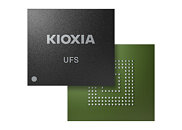- Joined
- Oct 9, 2007
- Messages
- 47,895 (7.37/day)
- Location
- Dublin, Ireland
| System Name | RBMK-1000 |
|---|---|
| Processor | AMD Ryzen 7 5700G |
| Motherboard | Gigabyte B550 AORUS Elite V2 |
| Cooling | DeepCool Gammax L240 V2 |
| Memory | 2x 16GB DDR4-3200 |
| Video Card(s) | Galax RTX 4070 Ti EX |
| Storage | Samsung 990 1TB |
| Display(s) | BenQ 1440p 60 Hz 27-inch |
| Case | Corsair Carbide 100R |
| Audio Device(s) | ASUS SupremeFX S1220A |
| Power Supply | Cooler Master MWE Gold 650W |
| Mouse | ASUS ROG Strix Impact |
| Keyboard | Gamdias Hermes E2 |
| Software | Windows 11 Pro |
Kioxia Corporation, a world leader in memory solutions, today announced the launch of Universal Flash Storage (UFS) Ver. 3.1 [1] embedded flash memory devices utilizing the company's innovative 4-bit per cell quad-level-cell (QLC) technology. For applications needing high density, such as cutting-edge smartphones, Kioxia's QLC technology enables the capability to achieve the highest densities available in a single package.
Kioxia's UFS proof of concept (PoC) device is a 512 gigabyte prototype that utilizes the company's 1 terabit (128 gigabyte) BiCS FLASH 3D flash memory with QLC technology, and is now sampling to OEM customers. The PoC device is designed to meet the increasing performance and density requirements of mobile applications driven by higher resolution images, 5G networks, 4K plus video and the like.

The samples are POC devices under development and have some feature limitations. Furthermore, specifications of the devices are subject to change without prior notice.
In every mention of a Kioxia product: Product density is identified based on the density of memory chip(s) within the Product, not the amount of memory capacity available for data storage by the end user. Consumer-usable capacity will be less due to overhead data areas, formatting, bad blocks, and other constraints, and may also vary based on the host device and application. For details, please refer to applicable product specifications.
All company names, product names and service names may be trademarks of their respective companies.
View at TechPowerUp Main Site
Kioxia's UFS proof of concept (PoC) device is a 512 gigabyte prototype that utilizes the company's 1 terabit (128 gigabyte) BiCS FLASH 3D flash memory with QLC technology, and is now sampling to OEM customers. The PoC device is designed to meet the increasing performance and density requirements of mobile applications driven by higher resolution images, 5G networks, 4K plus video and the like.

The samples are POC devices under development and have some feature limitations. Furthermore, specifications of the devices are subject to change without prior notice.
In every mention of a Kioxia product: Product density is identified based on the density of memory chip(s) within the Product, not the amount of memory capacity available for data storage by the end user. Consumer-usable capacity will be less due to overhead data areas, formatting, bad blocks, and other constraints, and may also vary based on the host device and application. For details, please refer to applicable product specifications.
All company names, product names and service names may be trademarks of their respective companies.
View at TechPowerUp Main Site


